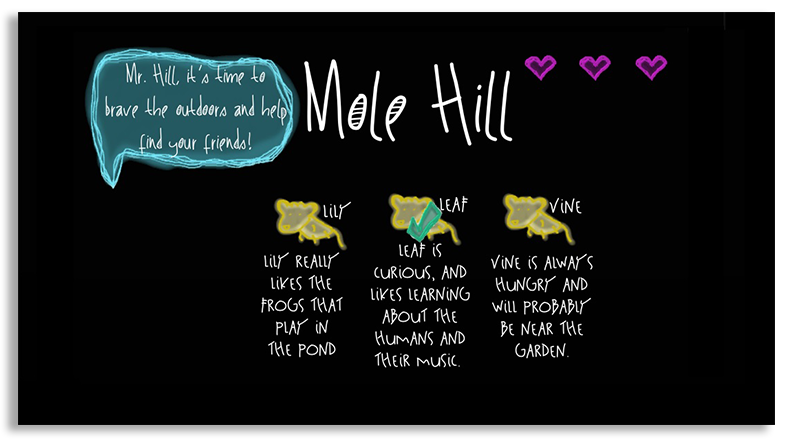What's in a Game?
“What’s in a Game?” prompted students to produce critical media by prototyping their own games. I focused the course on indie games and critical play, and I either required the use of a specific engine (Unity 3D) or ran with student preferences (often Twine or Python). When I taught the course, I did not assume students were gamers, had any experience with game design, or were even interested in games. By the end of the course, they would prototype only a level or scene, with credits and a title screen. They also created manuals for their games as if the games were complete. Then they shared their prototypes and manuals during an end-of-term event, such as “Open the Arcade” in 2017.
Below are undergraduate and graduate course descriptions and links to two course websites and syllabi. I also link to descriptions of undergraduate prototypes, a UVic News article and interview about the graduate course, the poster for “Open the Arcade,” and several talks I’ve given on games, including one at Stanford about how games, simulations, and design fictions figure into my media practice and pedagogy.

What’s in a Game?
Spring 2015 and Fall 2017 | UVic DH 350 and UVic English 508 | Undergrad course for 25 students and grad seminar for 12 students
Links: undergrad course site (HTML); undergrad syllabus (PDF); grad course site (HTML); grad syllabus (PDF); undergrad prototypes (HTML); UVic News piece (HTML); UVic interview (HTML); poster for “Open the Arcade” (PDF; by Danielle Morgan); talk at Stanford with slides (HTML); talks at Queen’s, Alberta, UVic, and UBC (HTML)
“What we call a videogame is not a product. It’s the creation of an author and her accomplice, the player; it is handmade by the former and personally distributed to the latter. The videogame is a zine.” — Anna Anthropy, Rise of the Videogame Zinesters
Undergraduate course (2015): HELLO! This is a course about making indie games. It’s also about demystifying technologies and understanding videogames as arguments about power, systems, and social relations. I will not assume you’re a gamer, that you want to be a gamer, that you’ve ever made an indie game, or that you know how to develop, program, or design games. But I will encourage you to craft an argument about culture through your own game prototype. In short, we’re going to use games to talk about what games do, can do, or should do. Looking forward to it! For more information, visit the course website.
Graduate seminar (2017): This seminar is about literary and cultural approaches to prototyping indie games—games as gifts, letters, ephemera, hacks, souvenirs, mix tapes, commentaries, glitches, jokes, tricks, satire, memoirs, self-care, lo-fi, bit collage, accidents, performances, activism, zines . . . We’ll play some games, read some history and critical theory, and experiment with an array of design and development techniques from paper to screen. Early in the term, you’ll select a few “-isms” (e.g., Futurism, Minimalism, and Surrealism) from the nineteenth and twentieth centuries that will inform your approaches to prototyping throughout the seminar, and by the end you’ll create and share your own indie games, complete with their own user manuals. In the process, you’ll learn about the intersections of new media with art, literature, and politics, and we’ll demystify the popular assumption that only a “select few” can make games. I will not assume that you are a gamer, want to be a gamer, have ever made an indie game, or know how to develop or design games. I will also not assume that you’ve taken a course in digital studies. Technical competency required: know how to send an email. As you play games throughout the term, I encourage you to support the authors and developers, most of whom accept donations via Patreon or the like.
We’ll study work by Aubrey Anable, Anna Anthropy, Mattie Brice, Nicky Case, Ed Chang, Naomi Clark, Mia Consalvo, Ben Esposito, Mary Flanagan, Toby Fox, Tracy Fullerton, Alexander Galloway, Patrick Jagoda, Brendan Keogh, Elizabeth LaPensée, Nathalie Lawhead, Lisa Nakamura, Allison Parrish, Celia Pearce, Amanda Phillips, Anastasia Salter, Emily Short, T.L. Taylor, Annette Vee, Noah Wardrip-Fruin, and Robert Yang. For more information, visit the course website.
Featured image of Twiggy from Adventures of a Sticky Leaf-Dweller by Mairi Richter, Ashley Howard, Jodi Litvin, and Donny Kimber. Used with permission. Image of Mole Hill, by krista coté, also used with permission. I created this page on 8 July 2019 and last updated it on 25 June 2024.